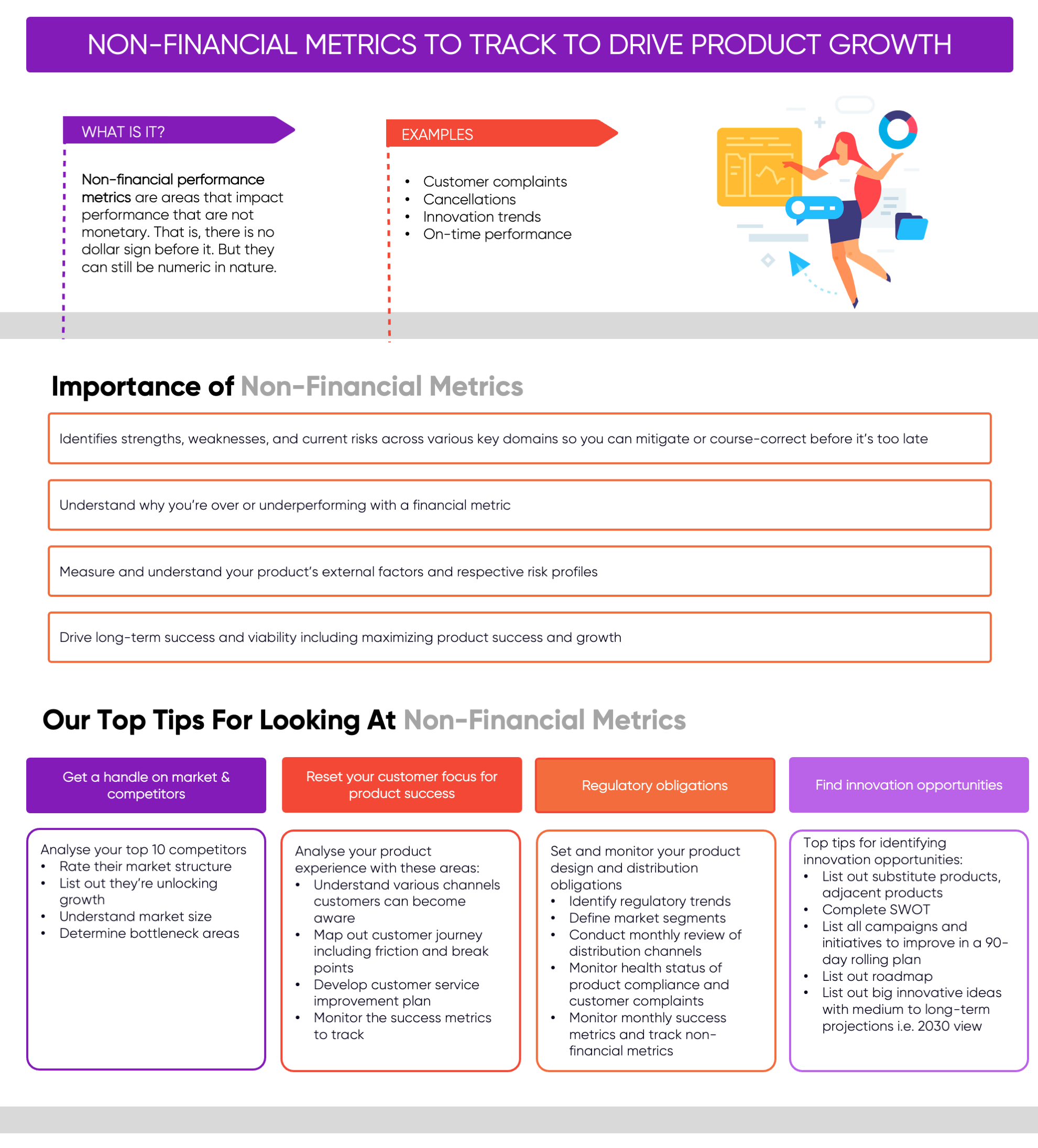Why every Product Leader should monitor non-financial metrics to drive product growth
by Helen Tsaganos

There is no doubt that as this decade progresses, investors, regulators, and the public are increasing their scrutiny of sustainability efforts and non-financial KPIs.
Below is our short infographic which highlights the key points to driving product growth using non-financial metrics. Read the blog article below for more detail.

Pressures are mounting to demonstrate and recognise the ongoing environmental, social, and governance (ESG) issues unfolding, and many are building and marketing their products accordingly.
Demand is rising for more accountability and greater regulatory scrutiny.
As product leaders face a more regulated future, digitising the post-launch stage of the product management lifecycle - is only a matter of time. This is especially important as non-financial factors continue to become a regulatory prerequisite and are a key component of the post-launch product lifecycle.
Product leaders who have already started the business on the usual journey of tracking non-financial metrics regularly (e.g., monthly or quarterly) and are placing equal importance on these as financial metrics will not only benefit in terms of having the knowledge to make the right strategic product decisions (especially when needing to course-correct risks unfolding early) but will also be in a sound position to meet the next wave of increased regulatory accountability head-on.
Today, a high-performing product team should instill this as part of their operating culture and their DNA, as it is an invaluable asset that will continue to grow.
Furthermore, today's and tomorrow’s high-performing product teams cannot sustain this without a digitised product monitoring governance framework with smart automation, there is no doubt about that. This ensures they can effectively manage the product lifecycle from end to end, with a seamless ability to track non-financial KPIs that are important to each product’s overall performance.
Almost everyone product manager and product leader have seen a product financial performance scorecard or been part of a regular product financial performance review that gives updates on a product or product portfolio's financial health.
Now let’s be real. In most scenarios, organisations care the most about financial metrics. After all, these are the numbers showing how much revenue, margin, and profit your products are generating and the forward-looking trajectory of these key metrics are key indicators that define the fate of the product and potentially the organisation.
As part of these regular product performance reviews, product leaders that also advocate and equally track non-financial metrics with KPIs will have a complete picture of the data and indicators needed to understand a product’s overall health and the forward-looking trajectory.
What are non-financial performance measures?
In its simplest form, non-financial metrics are not stated as monetary values—in other words, they do not have a dollar sign in front of them. They focus on other integral aspects of the product's end-to-end journey and are more often current and forward-looking indicators, whereas financial metrics are generally retrospective indicators. Whilst non-financial metrics are not financial that does not mean they are not numeric in nature. In fact, they can be either quantitative or qualitative.
Why are non-financial performance metrics important?
There are two key reasons non-financial metrics are important.
- They can help to explain and provide context for financial metrics. Financial metrics generally are retrospective indicators, which are easy to identify and conduct analysis on because they are backward-looking. This is because they report on what has already happened, such as the revenue generated, or sales orders placed for a specific period. This is a standalone data point that is not suitable in today's dynamic business environment. But financial numbers don’t always explain the complete picture. If revenue declines in a given period, why did this happen? Or if a particular cost increases why was this the case? Non-financial performance metrics can help to identify the missing pieces of information to explain financial metrics variations.
- Non-financial metrics KPIs can be associated with specific areas within your product strategy. Most product strategies that have a vision statement or a unique value proposition don’t have financial-based statements. If your products value proposition or objective is to provide the best customer service, financial numbers do not track this directly —but something like measuring customer satisfaction, net promoter score or complaints, the number of customer support calls, and so on are a factor to measure and understand the lay of the land as it is.
Why should product teams track non-financial performance measures?
Monitoring and reporting on financial metrics are essential and a priority, but it should be equally as important to also measure key non-financial metrics when understanding and reporting on product performance. Doing so will help arm you with the knowledge to:
- Identify strengths, weaknesses, and current risks across various key at-risk product domains emerging or in play so that you can mitigate, or course-correct before it's too far down the track. For example, if your customer journey has recently experienced long lead times for order fulfillment and a key part of the product strategy is to on-sell additional features to the customer within a given period from order fulfillment (as that is the best time to capture the value being realised by a customer) this measure would be an important non-financial metrics to monitor regularly. Tracking it regularly will be a key indicator when lead times are meeting objectives and identify when there are areas to be addressed and impacting overall performance.
- Understand why you are over or underperforming with a financial metric. For example, if the order fulfillment budget has increased significantly you will be able to relate it to the order fulfillment lead time increasing and the costs needed to incrementally support it due to problem areas within the order fulfillment category.
- Measure and understand your product's external factors risk profile. Every product has external risk factors that are outside its control which may have various degrees of adverse impacts on sales, revenue, or costs. For example, competitor activity, technological advancements, or the pandemic are some examples. If you are solely focused on financial metrics, you may miss the boat on understanding other key risks for your product’s future performance until it’s too late to mitigate or course correct.
- Driving long-term success and viability including maximising product success and growth – for example, customer satisfaction, ability to innovate, quality of the product, complaints, and support tickets are all key factors for continued growth contributors.
Our tips for looking at non-financial metrics
Get a handle on the market and competitors.
Markets are changing rapidly in our digital era, and it’s no longer enough to review your competitors on an annual basis. More and more product leaders need to assess their market, competitors, and value proposition regularly
- Analyse your market and competitors in these areas:
- List the top 10 competitors
- Rate their market structure — e.g. challenger, leader, emerging player, and visionary
- For each competitor list out how they are unlocking growth
- Compare your target market and value proposition– know your product buyer persona and influences
- Understand your market size and underlying year-on-year growth metrics so the
bottleneck can be addressed
Reset your customer focus for product success.
Customer engagement is a critical result area for all product managers. However, it can be challenging to understand all of your customer experience and engagement factors if your organisation is built around silos or has hand-offs between agile and product operation teams
Build out a customer journey map and key engagement metrics. Customer engagement includes awareness, consideration, and buying decisions through to any ongoing interactions (often called customer success). You can’t improve customer engagement and trust unless you measure it.
Tips
Analyse your product experience in these areas:
- Understand the various channels a customer can become aware of, consider and buy your product. List both direct and indirect distribution channels
- Map out a customer journey map, the friction, and breakpoints.
- List out the areas you want to measure and gather data on monthly and quarterly performance.
- Develop a customer experience improvement plan for your product.
- Monitor the success metrics monthly and track actions. Ideally, this would include ‘shadow buying’ and a visit to your customer service team to get their grass-roots input on what is driving customer complaints.
Regulatory obligations
Set the product design obligations for your product and engage your regulatory and legal teams to monitor and review any triggers or changes. Understand what a ‘negative’ market is for your product to avoid customer trust issues.
Tips
Set and monitor your product design and distribution obligations:
- First, start with a regulatory pipeline — the regulatory trends impacting your product.
- Define your market segments and target market for the product. For your ideal target market, define a product buyer and user persona — their needs, behaviours, and objectives.
- Conduct a monthly review of your distribution channels and make sure they understand any restrictions or conditions on your product.
- Monitor the health status of your product compliance and customer complaints
- Monitor the monthly success metrics and track non-financial risk actions.
Find innovation opportunities
Product innovation never stands still, and therefore you must have a routine to monitor, update and evolve your product innovation plans.
Product innovation can be an initiative that delivers a business outcome and solves a customer problem — growth, margin performance, customer retention or experience or regulatory compliance for product trust.
Tips
- List out the substitute products and adjacent markets for your product category and complete a SWOT analysis
- Define your industry dynamics
- List out all the campaigns and initiatives to improve your product in 90-day rolling plans
- List out your roadmap — new features or new products
- List out your big innovative ideas — things that are on the medium-term horizon — i.e. your 2030 view
Although launching a new feature or product might be the first thing that comes to your mind for product success. It’s essential to also think about disciplined updates of your product's 360-degree health status, risk profiles, and 90-day actions.
About Skyjed
Skyjed is an all-in-one AI-powered product lifecycle management and product governance SaaS solution that helps you manage your products from launch, sunset to exit.
Built for product managers, Skyjed is specifically designed to help you manage product portfolios and gain intelligent insights that support growth and revenue generation.
Benefit from:
- Integrated, collaborative workspace for your design, monitoring, product review, and reporting
- Unique AI-engine that yields product intelligence across non-financial and financial areas of risks to mitigate and opportunities to maximise
- Compliant record-keeping documents the entire history of your product, its lifecycle, and approval process available on-demand at the click of a button
- Ready-made templates, automated reports, event scheduler, tasks management, and powerful workflows and automation features give you back time so you can focus on the work that matters - driving strategic growth.
To get a glimpse of our platform in action, check out our Skyjed demo video.



